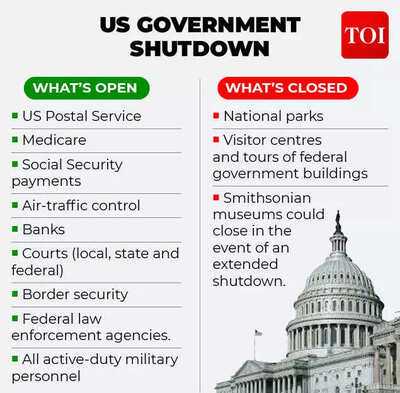The US federal government shut down on Wednesday after President Donald Trump and Congress failed to reach an agreement on a spending bill .
Hundreds of thousands of federal workers will be sent home without pay, and many government offices may close temporarily or even for good, making this the first shutdown since 2019.
With Democrats and Republicans pointing fingers at each other over the crisis, it has further shaken the spirit of American democracy in one of the world’s most powerful nations.
The impact of the biggest shutdown since 2019: In numbers
The shutdown furloughed as much as 89% of the workforce in some agencies, while in others it was less than 3%.
Employees working with pay, working without pay, and furloughed: Agency classification.
How the crisis is striking down America’s workforce
Roughly 750,000 federal employees are expected to be furloughed, with some facing permanent layoffs. Essential workers, including air traffic controllers, TSA personnel, military members, and ICE agents, will continue to work but will go unpaid until the shutdown ends. Social Security, Medicare, and Medicaid payments will continue, although some related services could be slowed.
Also read: Why is the 2025 US shutdown more serious?
The Pentagon has warned that about 2 million active-duty troops, including National Guard members deployed in US cities, could be forced to work without pay. The military will prioritise operations such as border security, missile shield construction, and critical munitions production. "Military personnel on active duty, including reserve component personnel on Federal active duty, will continue to report for duty and carry out assigned duties," the Pentagon plan said.
Who’s getting hit, and who stays on duty
Agencies that will keep operating:
 What led to the shutdown?
What led to the shutdown?
The shutdown became unavoidable after Senate Democrats blocked a Republican plan to keep the government funded until November 21. Republicans then rejected the Democratic proposal, which would have extended funding through the end of October and added more than $1 trillion for healthcare. With both sides refusing the other’s plan, no funding agreement could pass, leading to the shutdown.
Senate votes reflected deep partisan divides. The GOP measure fell 55-45, short of the 60 votes needed, while the Democratic plan failed 53-47. Following the votes, White House budget director Russell Vought instructed federal agencies to “execute their plans for an orderly shutdown.”
Hundreds of thousands of federal workers will be sent home without pay, and many government offices may close temporarily or even for good, making this the first shutdown since 2019.
With Democrats and Republicans pointing fingers at each other over the crisis, it has further shaken the spirit of American democracy in one of the world’s most powerful nations.
The impact of the biggest shutdown since 2019: In numbers
The shutdown furloughed as much as 89% of the workforce in some agencies, while in others it was less than 3%.
Employees working with pay, working without pay, and furloughed: Agency classification.
How the crisis is striking down America’s workforce
Roughly 750,000 federal employees are expected to be furloughed, with some facing permanent layoffs. Essential workers, including air traffic controllers, TSA personnel, military members, and ICE agents, will continue to work but will go unpaid until the shutdown ends. Social Security, Medicare, and Medicaid payments will continue, although some related services could be slowed.
Also read: Why is the 2025 US shutdown more serious?
The Pentagon has warned that about 2 million active-duty troops, including National Guard members deployed in US cities, could be forced to work without pay. The military will prioritise operations such as border security, missile shield construction, and critical munitions production. "Military personnel on active duty, including reserve component personnel on Federal active duty, will continue to report for duty and carry out assigned duties," the Pentagon plan said.
Who’s getting hit, and who stays on duty
Agencies that will keep operating:
- FBI investigators and CIA officers
- Air traffic controllers and TSA airport checkpoint agents
- Members of the Armed Forces
- Programs relying on mandatory spending (e.g., Social Security, Medicare)
- Health and Human Services: CDC continues monitoring disease outbreaks
- NIH: Current patients in studies continue receiving care
- National Park Service: Some parks may stay open (contingent on staffing)
- Roughly 750,000 federal employees overall could be furloughed
- Health and Human Services: 41% of staff furloughed; research into health risks paused
- NIH: No new studies; access to experimental therapies limited
- FDA: Many activities delayed or paused; new drug and medical device submissions not accepted
- National Park Service: Potential closures; limited staffing may affect visitor services
- Non-essential employees across federal agencies
The shutdown became unavoidable after Senate Democrats blocked a Republican plan to keep the government funded until November 21. Republicans then rejected the Democratic proposal, which would have extended funding through the end of October and added more than $1 trillion for healthcare. With both sides refusing the other’s plan, no funding agreement could pass, leading to the shutdown.
Senate votes reflected deep partisan divides. The GOP measure fell 55-45, short of the 60 votes needed, while the Democratic plan failed 53-47. Following the votes, White House budget director Russell Vought instructed federal agencies to “execute their plans for an orderly shutdown.”
You may also like

I ditched UK for sunny country where my salary doubled - I'll never go back

Oktoberfest closed after bomb threat and explosion leaves one dead

Poached eggs won't break or go wispy if you do 1 thing when cooking - no vinegar needed

Cong should apologise: Maha leaders amid Chidambaram's 'US pressure' remarks

Aimee Lou Wood wants to see 'nerds fall in love' in her new BBC show







